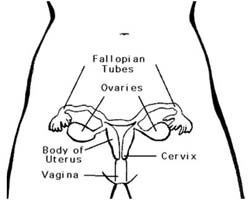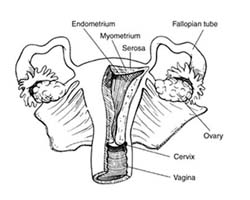Overview
What Is Uterine Sarcoma?
Uterine sarcoma is a cancer of the muscle and supporting tissues of the uterus (womb).
About the uterus
The uterus is a hollow organ, about the size and shape of a medium-sized pear. It has two main parts. The lower end of the uterus, which extends into the vagina, is called the cervix. The upper part of the uterus is called the body, and is also known as the corpus. The body of the uterus has 3 layers. The inner layer or lining is called the endometrium. The serosa is the layer of tissue coating the outside of the uterus. In the middle is a thick layer of muscle that is also known as the myometrium. This muscle layer is needed to push the baby out during birth. |
 |
Who is at risk for uterine cancer?
No one knows the exact causes of uterine cancer. However, it is clear that this disease is not contagious. No one can "catch" cancer from another person.
Women who get this disease are more likely than other women to have certain risk factors. A risk factor is something that increases a person's chance of developing the disease.
Most women who have known risk factors do not get uterine cancer. On the other hand, many who do get this disease have none of these factors. Doctors can seldom explain why one woman gets uterine cancer and another does not.
Studies have found the following risk factors: -
- Age. Cancer of the uterus occurs mostly in women over age 50.
- Endometrial hyperplasia. The risk of uterine cancer is higher if a woman has endometrial hyperplasia. This condition and its treatment are described above.
- Hormone replacement therapy (HRT). HRT is used to control the symptoms of menopause, to prevent osteoporosis (thinning of the bones), and to reduce the risk of heart disease or stroke.
Women should discuss the benefits and risks of HRT with their doctor. Also, having regular checkups while taking HRT may improve the chance that the doctor will find uterine cancer at an early stage, if it does develop.
- Obesity and related conditions. The body makes some of its estrogen in fatty tissue. That's why obese women are more likely than thin women to have higher levels of estrogen in their bodies. High levels of estrogen may be the reason that obese women have an increased risk of developing uterine cancer. The risk of this disease is also higher in women with diabetes or high blood pressure (conditions that occur in many obese women).
- Tamoxifen. Women taking the drug tamoxifen to prevent or treat breast cancer have an increased risk of uterine cancer. This risk appears to be related to the estrogen-like effect of this drug on the uterus. Doctors monitor women taking tamoxifen for possible signs or symptoms of uterine cancer.
- Race. White women are more likely than African-American women to get uterine cancer.
- Colorectal cancer. Women who have had an inherited form of colorectal cancer have a higher risk of developing uterine cancer than other women.
Symptoms
Uterine cancer usually occurs after menopause. But it may also occur around the time that menopause begins. Abnormal vaginal bleeding is the most common symptom of uterine cancer. Bleeding may start as a watery, blood-streaked flow that gradually contains more blood. Women should not assume that abnormal vaginal bleeding is part of menopause.A woman should see her doctor if she has any of the following symptoms: -
- Unusual vaginal bleeding or discharge
- Difficult or painful urination
- Pain during intercourse
- Pain in the pelvic area
Diagnosis
If a woman has symptoms that suggest uterine cancer, her doctor may check general signs of health and may order blood and urine tests. The doctor also may perform one or more of the exams or tests described on the next pages.- Pelvic exam - A woman has a pelvic exam to check the vagina, uterus, bladder, and rectum. The doctor feels these organs for any lumps or changes in their shape or size. To see the upper part of the vagina and the cervix, the doctor inserts an instrument called a speculum into the vagina.
- Pap test - The doctor collects cells from the cervix and upper vagina. A medical laboratory checks for abnormal cells. Although the Pap test can detect cancer of the cervix, cells from inside the uterus usually do not show up on a Pap test. This is why the doctor collects samples of cells from inside the uterus in a procedure called a biopsy.
- Transvaginal ultrasound - The doctor inserts an instrument into the vagina. The instrument aims high-frequency sound waves at the uterus. The pattern of the echoes they produce creates a picture. If the endometrium looks too thick, the doctor can do a biopsy.
- Biopsy - The doctor removes a sample of tissue from the uterine lining. This usually can be done in the doctor's office. In some cases, however, a woman may need to have a dilation and curettage (D&C). A D&C is usually done as same-day surgery with anesthesia in a hospital. A pathologist examines the tissue to check for cancer cells, hyperplasia, and other conditions. For a short time after the biopsy, some women have cramps and vaginal bleeding.
Treatment
Many women want to take an active part in making decisions about their medical care. They want to learn all they can about their disease and their treatment choices. However, the shock and stress that people may feel after a diagnosis of cancer can make it hard for them to think of everything they want to ask the doctor. It often helps to make a list of questions before an appointment. To help remember what the doctor says, patients may take notes or ask whether they may use a tape recorder. Some women also want to have a family member or friend with them when they talk to the doctor to take part in the discussion, to take notes, or just to listen.The patient's doctor may refer her to doctors who specialize in treating cancer, or she may ask for a referral. Treatment generally begins within a few weeks after the diagnosis. There will be time for the woman to talk with the doctor about her treatment choices, get a second opinion, and learn more about uterine cancer.
For more information, medical assessment and medical quote
as email attachment to
Email : - info@wecareindia.com
Contact Center Tel. (+91) 9029304141 (10 am. To 8 pm. IST)
(Only for international patients seeking treatment in India)










